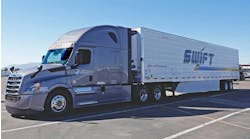Seasonal shift: Reefer fleets face deflated demand
For California produce shippers, and many others across the country, the “100 days of summer,” stretching from Memorial to Labor Day, marks the peak growing season—when refrigerated trucks are in high demand.
But the post-pandemic spike will look much different than in the previous two years.
U.S. shipments of fresh fruits and vegetables fell 18% year-over-year (y/y) during the last three weeks of April in a sign of what’s to come, according to a recent analysis of a U.S. Department of Agriculture (USDA) truck rate report by Arrive Logistics—which coordinates up to 700 reefer loads daily—going from 83,436 loads in the same period in 2022 to 68,116 last month, due in large part to the “atmospheric rivers” that inundated the West.
While they helped curb California’s drought, they also flooded agricultural fields, delaying or even destroying crops, and reducing seasonal volumes of fresh freight. As a result, reefer fleets will encounter only isolated markets with abundant produce freight this summer—when reefer rates are likely to remain depressed.
“Fleets will have to be more strategic on where they place their trucks,” Mitch Mazzaro, director of temperature-controlled solutions at Arrive, told Refrigerated Transporter. “In [Covid] years, if you found an available truck, it was ‘name your own price,’ and they could deadhead from San Francisco to the Salinas Valley. Now they’ll have to be smarter about where the previous delivery is happening, and how they’re going to position trucks to maximize pay, and start working through that information before finding a load.”
Market mismatch
U.S. shipments of fresh fruits and vegetables plunged 25% y/y in the first week of May—equating to 7,255 fewer loads for refrigerated fleets to haul, according to USDA statistics. Common shortages include artichokes, cabbage, carrots, grapes, and lettuce, many of which are key crops in produce hubs like California’s Salinas Valley.
See also: Exodus of fleets reaches historic levels in Q1
Some regions fared better than others in an unusually wet winter, and different commodities were uniquely impacted, Mazzaro said, leading to fragmented produce markets that will fluctuate as supply chains adjust. “There’s an entire North American shift that occurs,” Mazzaro said. “For example, we can buy tomatoes from greenhouses in Canada, or off the vine in Mexico. So some regions will be down, but they’ll be supplemented by others, and overall, prices for these commodities will be higher, but not by much.”
Combined with the pandemic influx of new motor carrier registrations, four of the 21 districts USDA tracks reported a surplus of trucks May 9, 11 reported adequate supply, and only six indicated a “slight” shortage—which likely isn’t enough truck demand to reverse an historic exodus of fleets from the market in the first four months of 2023. “We are going to see a normal spike in refrigerated freight, but it’s not going to outweigh the deflationary market we’re in,” Mazzaro predicted. “And if you bought into the market at peak, your costs are at peak, so what are you doing to mitigate that—and how do you keep trucks rolling?”
Return to ‘normal’
The national average load-to-truck reefer ratio tumbled to its lowest point in two years last month, falling to 2.7 in an indication of weaker demand for truckload capacity on the spot market, according to DAT Freight & Analytics. The ratio was 6.3 in April 2022. Declining demand for truckload services led to a dip in national average reefer rates, which fell 9 cents to $2.41 a mile, DAT reported—72 cents lower than in April 2022.
“It’s a shipper’s market again.”
To keep winning, fleet operators need to think more like their counterparts, Mazzaro advised.
“Shippers look to lock in pricing by saying, ‘We’ll use you all season,’” he said. “Truckers need that mentality, too. If you’re chasing spot loads to make a couple hundred extra bucks, what’s that going to do for you next week?”
Thinking differently
Arrive already is setting summer prices for shippers, Mazzaro said. To do the same, and lock in contractual freight, carriers need to focus on strengthening relationships, he advised. They also should identify the busiest lanes, stage trucks in “advantageous” markets, and plan routes in advance to maximize produce-hauling opportunities.
See also: April declines make May a pivotal month for freight
Another strategy is to look for adjacent temperature-controlled commodities, like poultry. The key is to understand the unique aspects of every load, and its shipper. “Everything has its own list of requirements, so we must make sure we’re actively communicating that to the drivers to set them up for success,” Mazzaro said.
And working with a logistics provider who understands the market can help.
“Carriers can obtain ‘core’ status with us by hauling a certain number of loads each month,” said Mazzaro, who helps manage a network of 70,000 dry van and reefer carriers, primarily with fleets in the 20-to-200-truck range. “So our goal is to get our core carriers as many loads as we can on a monthly basis.
“That can be tougher in the refrigerated space, but we’re doing it.”

![“In [Covid] years, if you found an available truck, it was ‘name your own price,’ and they could deadhead from San Francisco to the Salinas Valley,” Mitch Mazzaro, director of temperature-controlled logistics at Arrive Logistics, told Refrigerated Transporter. “Now they’ll have to be smarter about where the previous delivery is happening.” “In [Covid] years, if you found an available truck, it was ‘name your own price,’ and they could deadhead from San Francisco to the Salinas Valley,” Mitch Mazzaro, director of temperature-controlled logistics at Arrive Logistics, told Refrigerated Transporter. “Now they’ll have to be smarter about where the previous delivery is happening.”](https://img.fleetowner.com/files/base/ebm/fleetowner/image/2023/05/1x1/IMG_4175.64639a7dc4568.png?auto=format,compress&fit=max&q=45&w=250&width=250)



